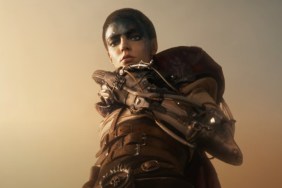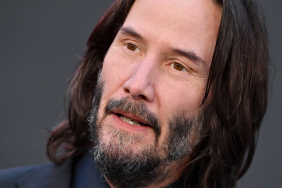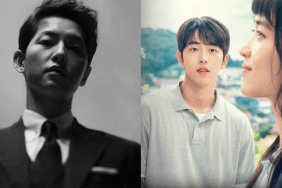Produced by France’s finest purveyor of action movies Luc Besson, the upcoming sci-fi action flick Lockout introduces the concept of Guy Pearce as an action hero, playing the wise-cracking Snow, a mercenary framed of murder convinced to help save the President’s daughter (Maggie Grace) from a group of escaped convicts at the space station prison complex MS One who’ve taken her hostage.
While the movie’s concept may sound vaguely familiar, harking back to the action and sci-fi movies of the ’80s and ’90s and more recent ones like the Besson-produced Taken (in which Maggie Grace was also kidnapped!), one of the greatest revelations about the movie is the impressive work by Irish filmmaking duo James Mather and Stephen St. Leger in creating a fun, exciting and stylish movie with terrific production values for a fraction of the cost of what a movie like this would have cost in Hollywood.
Although we had heard about the project a couple of times over the years as it tried out a number of different titles from “Section 8” to “MS One: Maximum Security,” Mather and St. Leger were a bit of a mystery, and there isn’t a lot of information or interviews out there about the duo who have mainly done shorts, commercials and British television. In fact, the short film they did called “Prey Alone” (which you can conveniently watch on YouTube) gives you a really good impression of what they’re able to do without having the budget or name actors of Lockout.
Intrigued by the mystery behind these unknown filmmakers from Ireland whose talents got the attention of Luc Besson, ComingSoon.net got on the phone last week with half the team, Stephen St. Leger, to talk about the movie and learn more about how he and his filmmaking partner work.
ComingSoon.net: I remember hearing about this movie a couple of times over the years, probably when Guy and Maggie came on board and again when FilmDistrict picked it up for release, but it’s been a mystery for some time. Was this something you and James had been developing for a long time?
Stephen St. Leger: What happened was James and I made a short film called “Prey Alone,” a 15-minute film and Luc Besson somehow got his hands on it, so he rang us up and said, “Why don’t you come to Paris?” We went over and met him and he said, “What are you guys doing?” James and I had been together for 20 years shooting commercials pretty much. James has shot some features and TV dramas in the UK and in Ireland, and we were at film school together nearly 20 years ago. We met up with Luc and he said, “I have this idea. What do you think?” And we said, “Okay, let’s go off and have a think about it,” so then we went off and we wrote up a 20-page treatment of the film. He said, “Great,” so we went off and wrote a first draft and came back to him, and he made a few changes here and there and we went off and did a second draft and that was it pretty much.
CS: About how long ago was that?
St. Leger: It was about two-and-a-half years ago when we started writing it, so we were about four or five months writing it. At the same time, we were kind of prepping it, because obviously, we shoot everything ourselves. We write it, we shoot it, we direct it, and for this film, Windmill Lane in Dublin set up a VFX company just for this film.
CS: I was curious how much crossover there was with “Prey Alone” in terms of the film crew and FX people or do you guys usually do that yourself from beginning to end?
St. Leger: On “Prey Alone,” James did nearly everything himself with a few pals in his house, just hooked up together, but no, for this, it’s just too big, there’s too many. I think they had about 80 guys, because there was quite a lot of VFX in it, stuff that you may not even know that it’s VFX, just backgrounds. James and I, we’re not really big fans of green screen to be honest. It’s just that nobody is going to give you the money so we had to do it that way, although on “Lockout,” it was deliberately done in the ’80s style, everything from the wardrobe to the set design, trying to do as much in-camera as possible, so we have big translights, massive pictures outsides of houses instead of doing green screen. Obviously, some had to be done in green screen whether it’s anti-gravity or whatever, but we tried to keep the style the way they used to shoot those kinds of movies in the ’80s, as opposed to the modern way, which is very glossy, very clean and high-tech. We wanted to sort of it do it more old school, if you like, the way that Ridley Scott and those guys were doing it in the ’80s.

CS: When you were writing the script, were you at the same time designing the world? It’s a fairly simple premise but there seems to be a lot of world-constructing involved including designing the MS One and LOPD space stations.
St. Leger: Yeah, we designed it. This guy Romek Delmata, who was the production designer, he was working with us, so we were prepping that for pretty much a year before we even started shooting, because at the end of the day, we only had eight-and-a-half weeks to shoot it, which is not a lot of time, so it was go, go, go, you know?
CS: What really impressed me is that the movie looks like it could have cost $100 million but it probably cost a third of that.
St. Leger: No, it’s certainly not a big budget (laughs) but you know, in a way–and I don’t mind it–it is leaning to a B-picture aesthetic, but that part of it is slightly deliberate. Luc and I were talking about the tone of the film, and Luc’s recent action movies he’s produced, there’s an awful lot of kicking heads if you like, but one thing that I wanted to do is that I wanted to try and go back to the stuff in the ’80s where the lead anti-hero is reluctant and vulnerable and when he gets hit, it hurts. He’s not super martial arts, and that’s something Luc used to do years ago in the ’80s with “Leon” and “Nikita,” so while we were writing it, we were aware of Luc’s films and those kinds of films of the ’80s and ’90s. I think it’s really obvious. (Laughs) I think the clip just went up on the ‘net where he cuts her hair to disguise her and that’s completely from “Nikita,” something that Luc did.
CS: Well, I love those movies, which is probably why I liked “Lockout.” Guy Pearce has done a lot of cool roles and movies, but he’s not the first person you’d think of as a wise-cracking action anti-hero. How did you end up with him?
St. Leger: Luc has a knack for that. (laughs) I think they said the same thing about Liam Neeson – “Could Oscar Schindler really be in a film like ‘Taken’?” I mean, Guy Pearce, he really is a brilliant actor–“Memento,” “L.A. Confidential”–and you’re right. A lot of his roles have been very serious, very earnest, and in “Lockout,” he’s the complete polar opposite of that. He’s not earnest at all. He’s blunt, he’s sarcastic, he’s rude, so I think when Guy read the script, he got it, and I think he wanted to try and have some fun with it. No, I think you’re right. It will be interesting to see what audiences think of him in this role, because it is definitely a different type of thing for him. I think he’s great in this, he really pulls it off.
CS: I think he pulls off what Bruce Willis used to do in the ’80s and ’90s with movies like “Die Hard” and why moviegoers still love him. It’s really hard to do that sort of thing, just to make running jokes throughout the movie.
St. Leger: Exactly. Humor, you gotta nail it right ’cause everybody’s opinion of what’s funny is different. It is a lot easier to do a suspense scene or an action scene whereas the comic timing, you have to be able to do it, but once he read the script and the dialogue, he nailed it. The other thing is the chemistry between him and Maggie (Grace), that’s something that has to connect, and that’s all separate to the actual physical (aspects). Guy obviously had to get in great shape for it, and it’s physically demanding, so you got that going on as well, but the humor is something that’s definitely what we wanted from the very start. You’re right. It’s like anything from Shane Black, you know, that kind of dialogue.
CS: I also think this might be part of the Irish sensibilities you guys bring to the mix, because other Irish filmmakers, like the McDonagh brothers, seem to have that sort of humor, so this ended up being a melding of worlds in that sense.
St. Leger: Yeah, at one point way, way back, the inmates were supposed to be American. Hydell and Alex were written a lot more vicious. They were really, really bad, and I decided to change that to Scottish, because I wanted to try and give them humor as well, and like you say, there’s something about an Irish or a Scottish accent that even quite vicious dialogue on a page can come across really funny and hilarious. Joe Gilgun, who plays Hydell, I think he’s just hilarious. He’s been in a couple indie movies in the UK. He was actually in a film called “Harry Brown.”

CS: Right, I think I saw him that. You mentioned that you don’t like doing green screen but things like the space station are fairly elaborate with a lot of different locations, so did you end up building a lot of sets practically or do them using CG?
St. Leger: We shot it in Belgrade, Serbia. We built all the sets in studios in Belgrade, so we had four or five (stages). The studio in Belgrade was a new build and they had all these new studios there, so I think we had four 20,000 square foot stages, all filled to the brim with sets. The other thing that James Mather did, which was really clever, was he built the sets for 3D and prelit them in 3D, so if you imagine him building all the sets and where the lights go in all sets, so you’re kind of prelit when you arrive, so you get all the electricians to light the sets as he had lit them on a 3D model, so everything is prewired and prerigged and set up and that allowed me to be a lot of freer and just follow the action without stopping and starting and trying to keep the fluidity of it going, which is what they used to do in the ’80s. They didn’t have the 3D technology but it’s that kind of thing, it’s what they used to do.
CS: You’ve obviously worked with James for a while now, and from what you say, he probably has an artistic and technical background, so how do you guys split up the directorial duties?
St. Leger: Yeah, because we’ve worked together so long, there’s very little discussion on the day. We pretty much answer each other’s questions, and he handles all the photography–he lights it, he shoots it, he operates the camera–and I pretty much stay with the actors and performances. What’s really good is because James has co-written it, not only is he thinking about lighting the scene, but he’s thinking about the next scene and the scene after that or the scene before and the lighting differences between them. Also, really quickly, he knows the intention of the scene, because he’s co-written it, and that’s a massive advantage from a camera or photography point of view.
CS: How was Luc as a producer? Did he go to Serbia while you were shooting?
St. Leger: No, Luc wasn’t around at all. He just left us to do whatever we wanted to do. He really became involved in the editing. When everything was shot and done, he sort of put his editing on it, which again, if you’re going for that style of what they used to do in the ’80s and ’90s, who better to have than Luc Besson in the edit bay editing saying, “This is what I would have done years ago”? But as far as the writing and shooting, it was kind of left up to us to do.
CS: What have you guys been doing since finishing this? Still shooting commercials?
St. Leger: Sleeping
resting. Yeah, we’ve just been taken some time off. We’re still shooting quite a lot of ads, and an awful lot of script reading and there’s a few things floating around, but obviously, I can’t discuss them yet, because they’re all top secret.
CS: But you’re looking at other people’s scripts as possible features to direct down the road?
St. Leger: No, we’re happy to look at any scripts if they’re good scripts. I love great dialogue and that kind of thing, so I read everything, and I read anything I can get my hands on. James and I keep writing together. We have two other scripts that we’ve written, so who knows? We might do those or something else, we’ll see what happens.
CS: Do you think you’ll work with Luc again?
St. Leger: Well, I dunno, yeah. Luc is a very busy guy. (chuckles) He’s doing five movies at the moment, but we keep in touch. I think he’s finished “Taken 2” – he’s got two other movies he’s doing, and I think he’s talking about doing his own sci-fi movie, so yeah, he’s pretty busy at the moment. (laughs) We keep in touch and we’ll see. Never say never.
Lockout opens nationwide on Friday, February 13.









